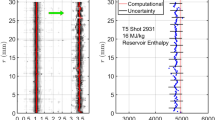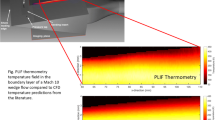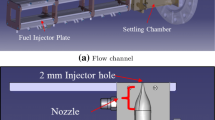Abstract.
Planar laser-induced fluorescence is performed in a free-piston shock tunnel by using a Raman-shifted tunable excimer laser to excite nitric oxide molecules in the flow. Two different flowfields are examined to test the difficulties associated with applying the technique to shock tunnels: the bluff body flow produced by a 25 mm diameter cylinder; and the oblique shock and expansion fan produced by a 35° half-angle wedge. For the cylinder, the maximum flow enthalpy was limited to 4.1 MJ kg\(^{-1}\) due to high flow luminosity which is produced by metallic contaminants in the flow. A reflective filter is used to reduce the influence of flow luminosity making these measurements feasible. Freestream temperature measurements are in excellent agreement with those predicted from numerical flow calculations. Large uncertainties were observed for the high-temperature post-shock results. Several higher enthalpy shots (14 MJ kg\(^{-1}\)) were also performed with the wedge and showed an insignificant amount of contaminant emission.
Similar content being viewed by others
Author information
Authors and Affiliations
Additional information
Received 5 June 1996 / Accepted 8 February 1998
Rights and permissions
About this article
Cite this article
Palma, P., McIntyre, T. & Houwing, A. PLIF thermometry in shock tunnel flows using a Raman-shifted tunable excimer laser. Shock Waves 8, 275–284 (1998). https://doi.org/10.1007/s001930050120
Issue Date:
DOI: https://doi.org/10.1007/s001930050120




